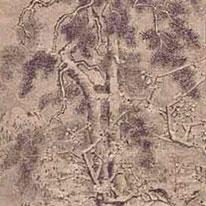Past Exhibitions
- Three Friends of Winter: Pine, Bamboo, and Plum in the Arts
- January 2, 2020 - January 26, 2020
Pine, bamboo, and plum, which flourish in early spring, are considered auspicious
motifs in Japan. They serve as celebratory symbols decorating all kind of artifacts that
are used during important annual events, such as New Year. Because the resilient plants
withstand the harshly cold winter season, they are also known as the "Three Friends of
Winter," and have been a favored subject matter not only in Japan, but also in East
Asian painting in general.
Chinese literati were the first who grouped the three plants together due to their noble
characteristics which they came to liken to the character of the ideal Confucian scholargentleman:
The pine had strong roots, the beautifully flowering plum a refreshing
fragrance, and the bamboo grew straight. Like these resilient plants flowering so
beautifully in winter, it was expected of the scholar-gentleman to cultivate a strong
character with which he would be able to show the same degree of perseverance and
steadfastness even during times of adverse conditions. The theme was favored for
calligraphy and monochrome ink painting, both practiced by Chinese literati.
In Japan, early on the subject matter of the "Three Friends of Winter" gained popularity.
This can be attributed to the influence of Japanese Zen monks of the Kamakura (1185–
1333) and Muromachi (1333–1573) periods who travelled to the continent and were
immersed in the world of Chinese monochrome ink painting. This section features
Japanese medieval ink painting related to the theme of the "Three Friends of Winter,"
painted in the environments Japan's Zen culture.












